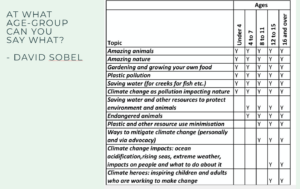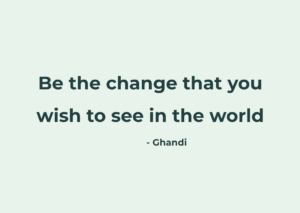Ecophobia or biophilia? Kids (and parents) today are being overwhelmed with pictures of burning fires, melting ice and plastic-filled oceans and many are feeling lost at what to do and how their little steps can truly make an impact.
So how do we approach topics like climate change and waste, so our children will feel empowered instead of scared, conscious instead of detached and feel ownership to their actions as our regenerative ambassadors?
Through my educator course at The Green School we looked at approaches to how we can teach sustainability to kids holistically, and I specifically spoke to Dr. Nicolene du Preez, Lower School Green Studies Program Developer and Integration Specialist on the topic of how we best parent with these challenges we are faced with.
In this article I will look at:
- The challenges of being a sustainable parent today
- How we can be role models?
- How we can talk to our kids about plastic pollution & climate change in a language the understand & without scaring them?
- How can we work together as a conscious and mindful family?
- What – on a more concrete level we can do together day-to-day to reduce energy, water & waste & preserve & regenerate our nature.
Let’s get started.
A very simple place to start is to look at how we approach our way of learning and how we pass this on to our kids. In the busy life as parents, we use our head to take in learning, we can grasp big concepts and we can understand what actions to take accordingly.
However, with kids, it’s different for them to learn, using the heart and their hands is essential. And by understanding this way of learning, we to can connect better with them – and nature we’re trying to save. Let me try to give an example.
In 2019, Dr Nicolene du Preez did a survey with a range of questions to primary kids at Green School aged 3-11. When asked “What do you think is the most important thing a scientist should study today?”, they answered the following:
- Climate change
- Nature
- Plastics
However, when asked what THEY wanted to study, they answered:
- Animals
- Plants
- Snakes
Dr Nicolene du Preez Kids realize the urgency.
“This whole process was eye-opening. The kids’ understand the urgency, they totally get that scientists’ should study climate change. But on the other side and for the second part of the survey, I almost see it as a divorce. You are asking these kids who are doing play-based learning and who would like to connect to their place and study animals and the snakes to then pick up the plastic in the river, and you might not be cleaning my own room. So they say ‘fine, if this is just another activity to sell to the world regardless of where we are in the world, I’ll just do it, but in my heart and in my mind I will be thinking about the animals, insects. “
Now, in the same survey, the children were asked another question: “if you could whisper into the ear of the earth – one word, what would you say?”
The answers were:
- Sorry
- Help
- Thank you
If you ask Dr Nicolene du Preez, she believes that the answers reflect the fact that the kids are the ones feeling the pressure as if they are the ones polluting the river or creating the climate change problem:
“They are sorry. They understand the urgency, they take full responsibility for the problems, even though they haven’t created them. The second answer, “Help” brings in the thought of whether they lost their trust in us as adults, in humanity? – but also the reassurance that the one regenerative resource they have, the earth, is there to help. We also see this in the third answer, where thank the Earth “
According to Dr Nicolene du Preez, we need to look below the ‘iceberg’, to the unconscious and not only
But what is underneath and why is it so important?
“We need to look at our kids as biocentric kids instead of egocentric. Naturally, in psychology, your younger kids will be eco-centric and this is natural. But you also see it in decision members and parliament with people who don’t care about climate change because ‘they are ok in the here and now’. However, if we navigate into a biocentric world view, where we get our kids to understand that we are sharing and living not just human to human but human to animals and all of us, to the earth – this brings out a new perspective. So as this transformation happens, we normally just see the top of the iceber, what is at eye-level and physical. But when you first stop and view this individual in front of you and start wondering what is below this iceberg, what is this child seeking to understand? There are some interesting thoughts that we often forget. And this is when we can start the connections.”
Question with all this, is how as parents do we rolemodel these kids that we want to be conscious and biocentric?
Here are Dr Nicolene du Preez’s suggestions, to how we as parents can look at ourselves and ask the questions are we ego- or biocentric ourselves?
- Implicit belief systems – what are beliefs on eg climate change?
- Do you really have a Big Head, Heart & Hand alignment?
- Are you telling your child to do something with your hands but not doing it yourself? Like telling your kids to clean up, but your helper is doing it for you – or telling them to join a beach clean when you wouldn’t have done it yourself?
- Reality check – be present and check-in with yourself before you do this race with your kids.
- Be the role model (your child is a mirror of you)
- Show not tell (don’t push it)

Another questions, is at what age group we can talk about the challenges with the environment and how? In his work, Beyond Ecophobia, Dr David Sobel suggests a range of environmental readiness stages.
To this Dr Nicolene du Preez adds:
“The readiness stages are great, but in our research, we realised that you need to be careful with kids that haven’t dealt with the previous stages. Say you have a child in grade 5 that has never found the animal allies and empathy – if he or she does not have the connection with nature, it will be very hard for him or her to be an advocate for environmental issues. So don’t take research just for what it is, see where your own kids are.”
Now, for us parents who are looking to incorporate these concepts into our daily lives (with kids in a ‘normal school’), what do you do? I asked Nicoline what her top tips are -to how you can start to communicate better with your child, so as not to scare them, but giving them hope. This is what she said:
So:
- Investing time
- Allowing children to explore
- Taking the risk
- Experiencing – stop & close your eyes
- Seek opportunity with no judgment
Nature walks, outdoor play, and if possible to combine with a beach cleanup that is wonderful. But doing it consciously, investing the time, release them in their play and exploration and then you will be able to join forces with the little green steps necessary:
Click here for Eco-tips from the kids for PLAY
Click here for Eco-tips from the kids for HOME
Click here for Eco-tips from the kids for being AWAY
Click here for Eco-tips from the kids for TRAVEL
Click here for our extensive list on HOW TO LIVE ZERO WASTE & HOW TO RECYCLE IN SINGAPORE
CLICK HERE TO LISTEN TO ZERO WASTE PIONEER BEA JOHNSON’S TIPS
CLICK HERE to get more inspiration from A Plastic Ocean director Craig Leeson’s tips
So in summary:
- Be mindful & Connect with nature – head, heart & hands
- Communicate positively about what we can do (Be aware of age)
- Take time out to act together with your child
- Let the work become play and let them choose – make it fun!
- Take small green steps as a family – together.
- Start today – take the leap





